|
PRESBYTERY OF DEER, SYNOD OF
ABERDEEN.
THE REV. JAMES WELSH, MINISTER.
I.—Topography and Natural
History.
Name.—New Deer was
originally a part of the ancient parish of Deer, from which it was
disjoined not long after the Revolution. It is termed in the ancient
records Auchreddy, from the name of the land in which the church is
situated. This name is engraved on the communion cups and plates, with the
date 1694. Like other Scottish names, it is of Gaelic origin, as are many
other names in the parish, such as Auchoach, Auchmaliddy, Auchna-gatt,
Auchmunziel.
Extent, &c.— It is one of
the largest parishes in the county of Aberdeen. Its greatest length from
north to south is upwards of 14 miles. Its greatest breadth from east to
west upwards of 8½ miles. Its contents upwards of 50 square miles.
Boundaries.—It is bounded
on the north, by the parishes of Stri-chen, Tyrie, and Aberdour; on the
west, by the parishes of King Edward, Monquhitter, Methlic, and Tarves; on
the south, by the parish of Ellon ; on the east, by the parish of Old
Deer.
Topographical
Appearances.—With the exception of the hill of Mormond, New Deer is the
highest ground in Buchan. No part of it, however, rises higher than 200 or
300 feet above the level of the sea. From the hill of Culsh, in the
neighbourhood of the village, may be seen in a clear day the spire of
Peterhead, about eighteen miles distant to the eastward. And, looking
west, may be seen Bennachie, about twenty-five or twenty-eight miles off,
the Foudland Hills, the hills in the neighbourhood of Banff and Cullen,
and Benrinnis, in the county of Moray. The elevation 'of the hill of Cross
Gight is rather higher than that of Culsh.
Hydrography.—There are no
streams that deserve the name of rivers in this parish, the country being
in general flat and all arable. It will give some idea of its elevation to
mention, that branches of three rivers, running in three different
directions, take their rise in the north part of this parish, not far from
each other. One of them flows eastward towards the Ugie, passing Old Deer,
and entering the German Ocean north of Peterhead. Another flows westward,
and joins a stream that falls into the Deveron, which empties itself into
the Moray Frith at Banff. A third flows south-westward, and joins the
Ythan near Gight, which falls into the German Ocean at the Newburgh. All
these three are but small streams.
Though New Deer is in the
centre of a circle seventeen or eighteen miles distant from the sea on
three sides, yet from its elevation the climate is cold ; the snow lies
long, and often delays the operations of husbandry. The south and west
winds are most prevalent; they are more violent than the east or north.
But though the climate is cold, it is dry and healthy, and the inhabitants
live to a great age, many exceeding eighty or ninety years.
The prevailing distempers
are inflammatory complaints, arising probably from the people using too
much oatmeal. Scrofula, too, ' is very common, as also are consumptions
and gravellish complaints.
Soil.—The soil in general,
with few exceptions, is light and shallow. It would answer well for
agriculture if it were not for the climate and the subsoil. A great
proportion of the parish rests on a hard rocky pan of from 6 inches to 2
feet thick, which prevents the surface water from sinking into the earth,
and keeps the soil wet till the sun evaporates the moisture. This pan
prevents trees from thriving and coming to any size. Attempts have been
made, and in some cases successfully, to break up this pan, and give the
surface water a passage into the earth.
In some parts the subsoil
is moss on coarse clay, on others it is mixed with a coarse granite. Lime
of indifferent quality is found in the land of Barrack. The farmers quarry
it for themselves, and burn it either for building or for putting on the
land.
There is. plenty of moss in
the parish, though it is wearing away apace either by improvement, or by
consumption as fuel. The part of it that has been cultivated, produces
excellent crops when mixed with shell sand from the sea side. The country
appears to have been once covered with wood, from the remains of trees
that are dug out of the mosses, though it is somewhat remarkable that none
these trees are fir.
II.—Civil History.
The materials for the
history of this parish are very scanty. The inhabitants are a primitive
race of people, and in many respects as for advanced in civilization as
their neighbours. They have but small encouragement for improvement, as
there are no resident heritors to set them an example. Dr Mavor, a
celebrated compiler of voyages, travels, &c. was a native of this parish,
being born in the land of Culsh.
Heritors.—There are nine
heritors; of these only two have houses in the parish, and reside there
occasionally. The heritors are, The Earl of Aberdeen; Mr D. Dingwall of
Brucklaw; Mr Gordon of Cairnbanno and New Deer; Mr Gordon of Nethermuir,
Mr Dingwall Fordyce of Culsh; Captain Ferguson of Pitfour; Mr Forbes
Irvine of Schivas; the Trustees of Mr Gordon of Murtle; and the Trustees
of the late Mr Simpson of Colleyhill. The proprietors of Brucklaw and
Nethermuir have residences in the parish.
Parochial Registers.—The
session records commence 1705. A portion of them, from 1727 to 1734, is
lost. Since that period they have been regularly kept; and the old
practice is still continued of entering each Sunday the text and the name
of the minister who preaches.
Antiquities.—There are, or
rather there were, many remains of Druidical temples and funeral
monuments, to be seen in the parish. One of them, about a mile north of
the village, still retains the name of the Standing Stones of Culsh,
though the stones stand there no longer, having been taken away, about
seventy years ago, to build the old manse. There are occasionally found
many tumuli, which, when opened, contain urns of baked clay, filled with
human bones and ashes. Not long ago, a farmer in the neighbourhood of the
village, in improving a piece of ground, dug up six of these. These urns
had neither top nor bottom. They were like chimney cans of baked clay,
rudely formed, about 15 inches long, and filled with bones and ashes.
Two miles north of the
village, stands the old Castle of Fedderate, now a complete ruin. Nearly
all the best stones have been taken away by the farmers for building. It
appears to have been once a place of considerable strength. It stands now
in the middle of a field. A morass, now drained and improved, surrounded
it, and the only access to it was by a causeway and a draw-bridge. Water,
it seems, had been conveyed to it by means of pipes, for pieces of them
have, at different times, been torn up by the plough. There is no
tradition as to when it was built. The floors are all arched with stone.
It came into the possession of the Irvines of Drum, and is now the
property of Lord Aberdeen. [Since this was written, the greater part of
the lands of Fedderate has been sold to Mr D. Dingwall of Brucklaw, who is
now by this purchase the principal heritor in the parish.] It is said to
have been one of the last strongholds of James II.'s partisans, who, after
the battle of Killiecrankie, possessed themselves of Fyvie Castle, and,
being obliged to abandon it, took refuge in Fedderate, but were pursued
and expelled from thence by King William's troops.
About a mile to the west of
the village is an extensive piece of moor called Bruce Hill. This is said
to have derived its name from Edward, brother to Robert the Bruce. Here he
is reported to have encamped after the battle of Inverury, and from this
to have gone in pursuit of the Cummins to a place near Old Deer, called
Aikey Brae. In memory of this victory, the market of Aikey fair is said to
have been established on the spot where the battle was fought.
III.—Population.
At the publication of the
last Statistical Account, the population of New Deer was 2800, being 1324
males, and 1476 females.

From a survey taken lately on account of
church extension, it was found to amount to 3621. It has been gradually
increasing at the rate of one per cent. per annum, 10 per cent, each
census. There are between 300 and 400 of the population located in the
village of New Deer.
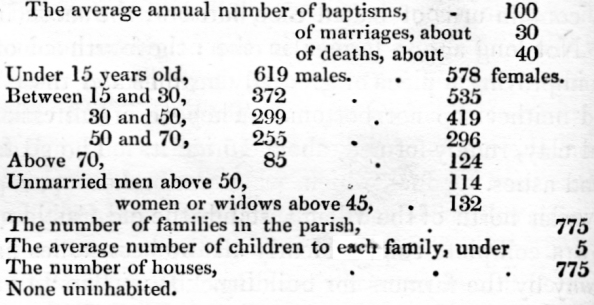
There are few or none
blind, insane, deaf, or dumb. The number of all in these classes does not
exceed 5 or 6.
Number of illegitimate
births during the last three years, 32.
IV.—Industry.
The parish is entirely an
agricultural parish, and all the inhabitants are in some way or other
engaged in this occupation. The farms, in general, are small; many of them
mere crofts; and consequently, they are managed by the farmer's family.
The contents of the parish
in imperial acres are as under, belonging to the respective heritors.
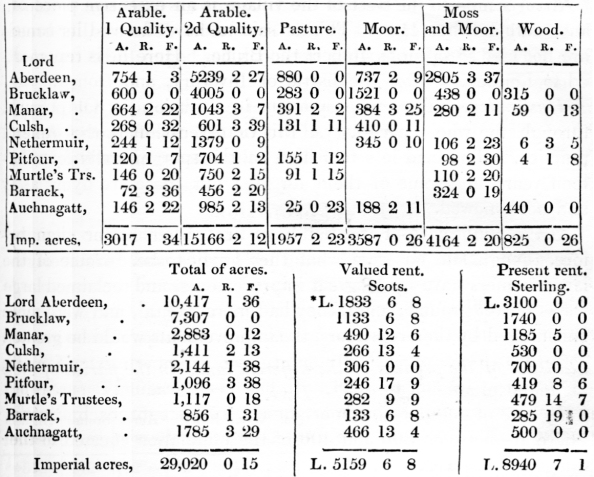
* From Mr D. Dingwall's
purchase of the lands of Fedderate, his valued rent has increased to
upwards of L. 1800 Scots, while Lord Aberdeen's is only L.1100. The valued
rents, however, are not yet split, so as to determine it accurately.
The first column contains
the nine heritors; the second and third columns, the land always in
regular crop; the fourth column is pasture, partly green and wet, and
partly heather and dry; the fifth column is moss or heather, and has once
been in cultivation, as appears from the marks of ridges throughout it.
The sixth column is the moss used for fuel, which, when not broken up, is
pastured. The seventh column is young planted wood, generally larches and
Scotch firs. The only part of this that appears to be thriving is some
planted fifteen years ago near Brucklaw. The fifth and sixth columns are
diminishing by being taken into cultivation.
Rental, &c.—The average
rent of the best land may be from L. 2 to L. 3 an acre; the second quality
from 10s. to L. 1. A very marked degree of improvement has taken place in
agriculture since the publication of last Statistical Account.
The rate of grazing for
cattle is from L. 1 to L. 1, 15s. ahead; of sheep from 5s. to 10s.
Wages.—Labourers receive
1s. 6d. a-day often hours and their meat, or 2s. a-day without meat.
Masons and carpenters work at the rate of 3d. an hour.
Live-Stock.—The Buchan
breed of cows is still much valued, and more so when crossed by the
Teeswater. The smaller breeds are not now so saleable since live-stock has
begun to be transported to London.
Husbandry.—The same system
of cultivation is not pursued through the whole parish. A five or
seven-shift is the general practice. The land lets very high; the leases
generally for nineteen years, and some of them for life; but these are
dying away and not renewed.
Farm-Buildings.—Farm-buildings are rather better than before, though still
far from what they ought to be. Some of the large farmers have made great
improvements, and reclaimed large tracts of wet ground; and if they had
more capital, and were more encouraged by the proprietors, the
improvements would be greater.
Statistics of the produce of
the different lands in the parish of New Deer.
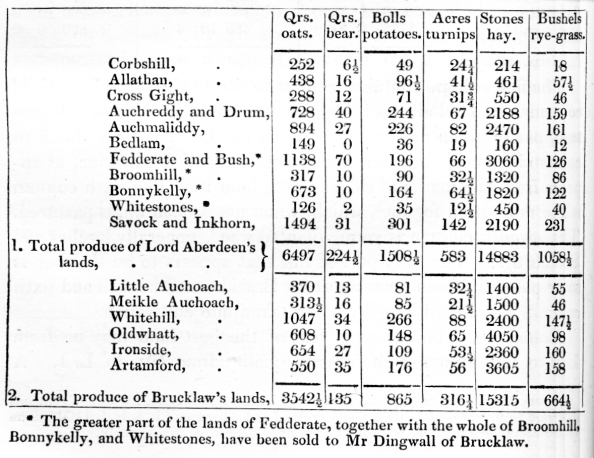
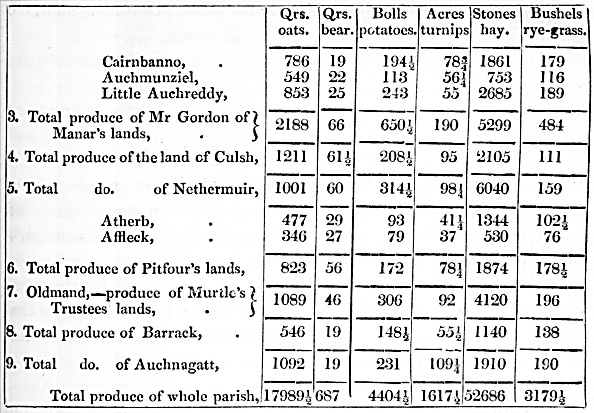
The above items of produce
were obtained by actual inquiry at the respective farmers. Of the 17989½
quarters of oats, not more than one-fifth can be reckoned as of first
quality—that is, there are 3597 quarters of oats of first quality, the
remainder, 14392½ quarters, are of second quality. The land of Brucklaw to
the extent of 100 acres is laid out in grass, and let for pasture. In
Artamford there are 55 acres of similar description; in Nether-muir 40
acres; and in Little Auchreddy 40 acres. Rent about L.2, 5s. per acre.
Produce.—The following is
as near an approximation as could be made to the amount of produce from
the cultivated land as well as from the uncultivated:
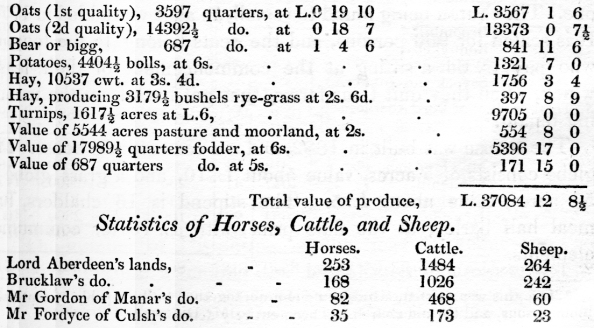

V.—Parochial Economy.
Village.— There is but one
village in the parish, New Deer, containing upwards of 100 houses, 90 on
the property of Mr Gordon of Manar, and. the remainder on Lord Aberdeen's
property. It lies on the ridge of a hill, and the fields decline to the
east and to the west of the street. It is situated nearly at an equal
distance from Banff on the north-west; Fraserburgh on the north-east;
Peterhead on the east; and the Newburgh on the south. It is distant from
Aberdeen nearly north thirty miles.
Means of
Communication.—There is a daily post from Aberdeen, through Methlic, and
the communication is carried on to Strichen, Peterhead, and New Pitsligo,
and Banff. There are nearly 100 miles of roads in the parish; a good road
great part of the way from New Deer to Ellon, distant thirteen miles. The
turnpike-road from Peterhead to Banff crosses the parish; and a mail-coach
regularly travels from Peterhead to Banff, and returns the same day. There
is a stage-coach thrice a-week from Aberdeen to New and Old Deer and
Strichen, through Ellon.
Ecclesiastical State.—The
parish church is a very old and ruinous building. There is a date on it of
1622. It is about seven miles from the north and south extremities of the
parish. It is in a very bad state of repair; but the heritors are about to
erect a new one. The church being found too small, an aisle was added in
1773. It is seated for 900 persons, and the seats belong to the tenants,
who pay 1s. 6d. a sitting at the commencement of their lease, which, when
they quit their farms, they get back from the incoming tenant. [Since this
was written, a handsome church has been built, capable of containing 1500
persons, and the old church has been entirely demolished.]
The manse was built in
1832, and is a commodious house. The glebe consists of 5 acres, value
about L. 10, and a grass glebe of 5¾ acres, value about L. 5. The stipend
is 16 chalders, half meal half barley, at the fiars price, with L. 10 for
communion elements.
To accommodate the people
at the south of the parish, and parts of the neighbouring parishes of Old
Deer, Ellon, Tarves, and a small portion of Methlic, a chapel has been
erected at the cost of about L. 700, calculated to seat 700 persons; but
no minister has been yet appointed for want of funds. It is regularly
supplied with divine worship by the ministers of New Deer, Old Deer, Ellon,
Tarves, and Methlic.
There are three Dissenting
meeting-houses belonging to the United Secession in the parish. They were
all established there before the time of the present incumbent. The
ministers are paid by voluntary contribution, some of them L.70 or L.80,
and sometimes less.
In the north part of the
parish those who are at a distance from the parish church are accommodated
at the chapels of ease at New Byth and New Pitsligo.

The number of Dissenting
families may be about 120; the number of those attending the Established
Church, 657. The average number of communicants that attend the
Established Church and communicate is 1240. [The above attend at the
parish church; the remainder at the surrounding parish churches; some at
New Pitsligo. some at New Byth, some at Methlic, some at Strichen, some at
Old Deer, and some at Monquhitter.] They all attend the ordinances of
religion regularly.
Education.—There are three
parochial schools, endowed with the minimum salary each. The parochial
school in the Kirktown is in very bad repair, and the heritors will do
nothing to renew it, not conceiving themselves obliged by the late act of
Parliament. The branches taught in the three parochial schools are,
reading, writing, arithmetic, book-keeping, Latin, Greek, mathematics.
Some of these are but rarely required. The salary of each of the
schoolmasters is L. 21, 7s. 9d. The amount of the school-fees of all three
is L. 62, 9s. 10d. One of them as session-clerk has in perquisites L. 5,
10s.
There are also six private
schools on the teachers' own adventure, two of them taught by females. The
common branches of education are taught in them.
In addition to their other
emoluments, the three parochial teachers derive from L. 20 to L. 80 each
annually from a mortification made by the late Mr Dick of Forres.
Education.—

With the exception of some
very aged people, there are but very few above fifteen years of age who
cannot read and write in a tolerable manner. The people in general wish to
learn, but their poverty compels them to remove their children during the
busy season from school, and put them to labour.
Library.—There is a library
kept in the village; the books are in circulation among the members, and
exchanged once a month.
Poor.—There are between 70
and 80 persons on the poor's roll, and every prospect of the number
increasing. They receive from 6s. to L. 1 a quarter, and some of them 2s.
6d. a-week. The fund to supply this expense arises from the interest of
L.700 stock, and the weekly collections, the latter amounting to upwards
of L. 50 per annum. There are other incidents, as the proceeds of a
mort-cloth, and occasional contributions from some of the heritors, and
other individuals. I am sorry to see that the disposition among the poor
to resort to parochial relief is increasing. The Dissenters contribute
little or nothing to the support of the poor. A change of the law
compelling them to support their own poor would be very desirable.
Fairs.—There are five fairs
held in the village annually. One in April; a feeing market in May; and a
market in June ; one in October, and a feeing market in November; at all
these, horses, cattle, sheep, &c. are exposed to sale.
Inns.—There are three inns
in the village. Two of them principal ones. Spirits are also sold by most
of the retailers of tea and tobacco. These, however, through the whole
parish, do not exceed eight or nine.
Fuel.—The fuel principally
used is peat, procured from the neighbouring mosses, at the cost of about
1s. 9d. a cart load.
Revised January 1840.
See also...
Sketch of a Quiet Buchan
Parish
By the Rev. Thomas M'William, M.A., Minister of New Byth (1899) (pdf) |

